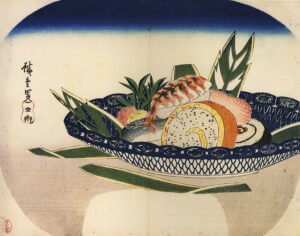What is the definition of the word ‘sushi’ ?
If we asked you to think about a type of food from Japan, and only one – we bet the first word that come to mind is ‘sushi’. We can understand, from all the different Japanese cultures and traditions, sushi is the #1 food that has gained world-renowned recognition.
But what does ‘sushi’ even mean ? Does it really come from Japan ?
Today, we would like to give you a little definition of the word ‘sushi’ and also give you a few explanations about its origins.
Sushi: a definition
The word ‘sushi’ (寿 司) is constructed from the words ‘su’, which signifies ‘vinegar’ and ‘shi’, which signifies ‘rice’. Following this logic, sushi literally refers to a product with a base of Calrose sushi rice and vinegar.
On top of the vinegar infused rice, sushi is also accompanied by neta (寿司ネタ), the additional ingredients like raw fish, vegetables or even fruit, and often with a algae sheets (nori – 海苔).
The different types of sushi
Nowadays, the term ‘sushi’ doesn’t necessarily refer to a specific food product. Instead, it refers to a family of products cooked with vinegar infused rice, algae leaves/sheets and fish.
Thusly, futomakis, hosomakis and nigiris are all considered ‘sushi’s’.
You’re having trouble telling the difference between a futomaki and a nigiri? We got your back, check out our article on the different types of sushi (French only).
What is the country of origin of sushi ?
Short answer: As we know it today, sushi comes from Japan (we’re pretty sure you guessed that already, no ?)
But it’s important to know that today’s version of sushi hasn’t existed for quite long.
The utilization of rice with fish has existed for quite some time, but they weren’t meant to be eaten together. Initially, the idea of combining rice with fish was for conservation of the fish. Nothing else.
By mixing rice and fish in a jar, the rice would ferment and produce lactic acid which had the effect of preserving the much more valuable fish. When someone wanted to eat fish, they would simply take it out of the jar and throw away the rice.
And know what ? This technique was actually Chinese and not Japanese ! Yup ! According to historical documents, this technique was first used by Chinese societies in 2nd century BC. Since these societies did not have available the wonderful stainless-steel fridges of today to keep their fish cold, they had to show some resourcefulness. The idea of fermenting rice was thus born.
It is not until the 8th century that this unique conservation technique was spread to Japan and in the 17th century that they started mixing fermented rice with fish – to eat it.
Today, rice is rarely fermented. Rather, we more commonly use a specially made vinegar for sushi rice to reproduce the acidic taste of fermented rice.
Who invented sushi?
As we know it today, sushi appeared in the 19th century (around 1820) in Tokyo (called Edo at the time). It is around this time Japanese societies had started eating balls of fermented/vinegar infused rice on which they would rest raw fish.
Why at this specific period? Around this time a travelling merchant, Hanaya Yohei (1799-1858) had the great idea and starting selling these balls.
Thanks Hanaya!
He would make his sushi in his yatai, an ancient ‘food cart’ similar to today’s foodtrucks and would travel across the city selling his creations.
I don’t think we have to tell you it was a success!
Hanaya Yohei’s creations became so popular, the famous Japanese painter Hiroshige immortalized them:
And there you have it ! You now know the definition of the word ‘sushi’ and learnt a bit about their origin.
If you would like to know more about the universe surrounding sushi, don’t hesitate to consult our fabulous sushi blog !
Published on
8 March 2022

